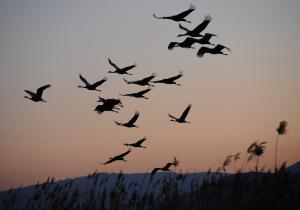CLEVELAND, Dec. 7 (UPI) — Birds have a strong preference for nighttime migration, so much so that migratory birds caught over water at daybreak turn around for shore. Researchers discovered the phenomenon using radar normally reserved for tracking weather systems.
As the radar revealed, birds flying over the Great Lakes when the sun rises typically increase their elevation and turn back. Researchers suggest the elevation rise is an attempt to gauge the distance to the far side of the lake.
The phenomenon explains the pile up of migratory birds on the northern shores of lakes during the fall and early winter when birds make the trek south for warmer climes. Conversely, birds concentrate on southern shores when they return in the spring and summer.
The recent study, published in the journal The Auk, found concentrations of birds were 48 percent denser on northern shores than southern shores of the Great Lakes.
“Our study justifies the high value of shoreline habitats for conservation of migratory bird populations in the Great Lakes region,” Jeff Buler, a researcher at the University of Delaware, said in a news release. “It also emphasizes that the extent of stopover use in shoreline habitats is context-dependent.”
“We hope professionals charged with managing stopover habitats recognize that shoreline areas can receive high migrant use by virtue of the proximity to a lake and how many migrants are aloft at dawn from day to day, rather than [just] by the presence of abundant food sources in these habitats,” Buler added.

COMMENTS
Please let us know if you're having issues with commenting.